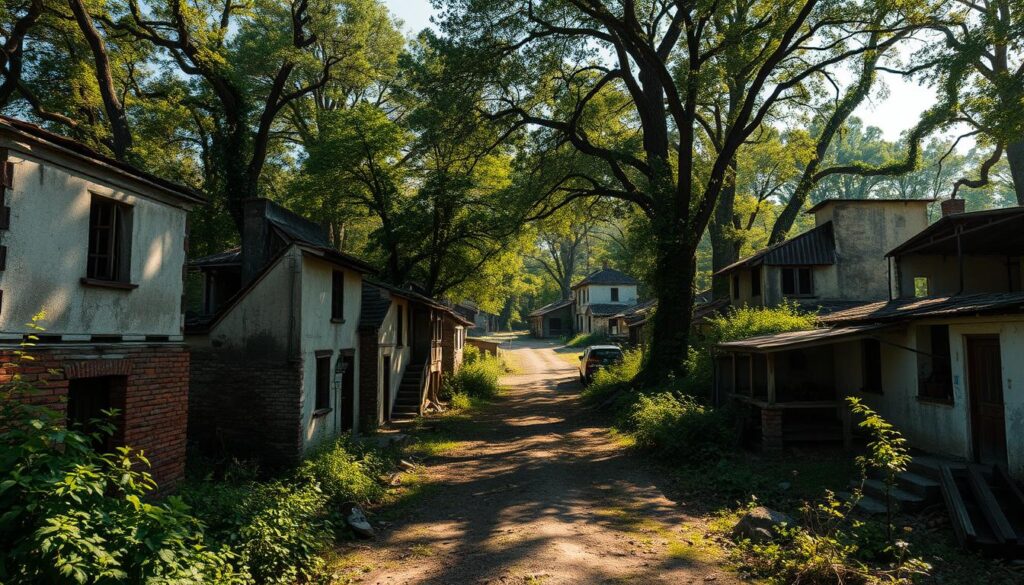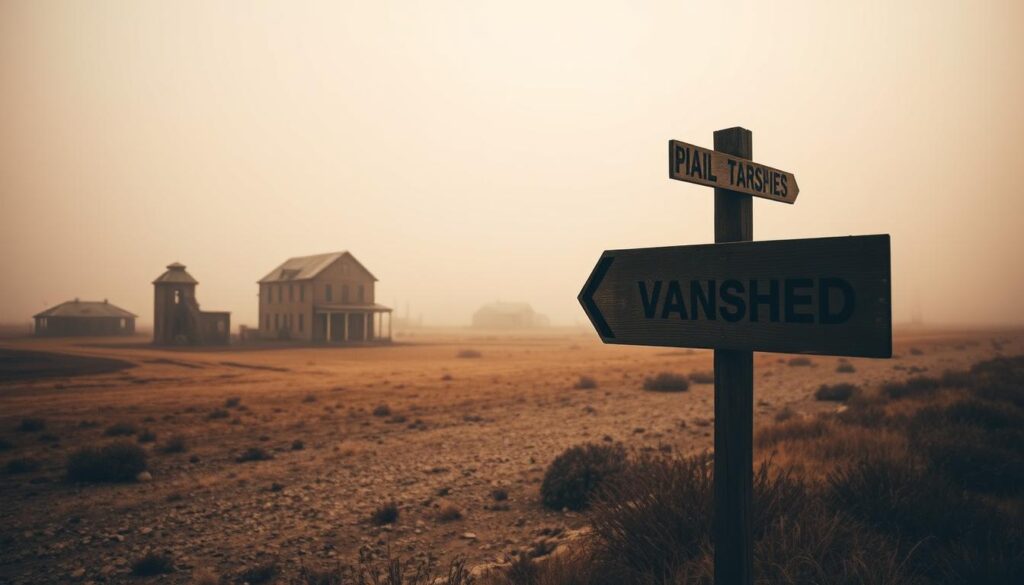Deep in history’s forgotten corners lies a chilling tale. A remote village, once full of life and laughter, emptied overnight. Today, it stands frozen in time, with dishes still on tables and beds unmade. Yet, not a single inhabitant was found.

The mystery of entire populations disappearing has long fascinated us. This ghost village is one of history’s most baffling cases. No bodies, no signs of struggle, and no explanation for why an entire community vanished.
What’s unique is the everyday items left behind. Valuable possessions were untouched, suggesting no planned evacuation. Personal belongings sat waiting for owners who never returned, creating an eerie snapshot of lives interrupted.
For decades, historians, paranormal investigators, and scientists have tried to solve this mystery. They’ve proposed theories from natural disasters to supernatural events. Yet, the truth remains elusive.
Key Takeaways Eerie Village
- An entire Eerie Village population disappeared without explanation, leaving belongings behind
- No human remains were ever discovered at the abandoned community site
- Personal possessions and valuables remained untouched, ruling out robbery
- Daily activities appeared to have been suddenly interrupted
- Both scientific and supernatural theories exist about the mysterious disappearance
- The case remains unsolved despite decades of investigation
- Similar historical disappearances have occurred in other locations worldwide
The Mysterious Disappearance That Haunts History
This vanished community’s story is one of the most chilling historical mysteries. Unlike natural disasters, this disappearance left no signs of struggle. Homes, belongings, and even meals were left untouched, but the people were gone.
No clear reason exists for this event. There’s no violence, no graves, and no signs of panic. It’s as if the people vanished into thin air.
First Reports of the Eerie Village
A merchant found the Eerie Village when he arrived. He expected to trade but found silence instead. Doors were open, and animals roamed free.
He wrote about his growing unease as he searched for anyone. Every home was empty, leaving him with no answers.
Initial Reactions from Neighboring Communities
News of the empty village spread fast. Search parties found the same eerie scene. People from nearby towns were too scared to enter after dark.
They thought maybe sickness or tribal conflicts were to blame. But no evidence supported these theories.
Official Documentation of the Incident
Government records show the village was suddenly empty. Military reports and church records confirm this. It’s a mystery that has puzzled people for centuries.
This case is unique because it’s well-documented. Unlike many tales, this event is backed by multiple sources. Yet, it remains a complete mystery.
Location and Setting: Where Was This Infamous Eerie Village?
The lost Eerie Village was hidden in a valley between mountains for centuries. It was at the crossroads of three old trade paths. But, it was deep in a dense forest, making it hard for outsiders to reach.
The village’s location made it mysterious. It was surrounded by steep cliffs and a winding river. Winter snow blocked the only path to other towns, isolating it for months.
This remote spot shaped the village’s unique culture. It had fresh water, fertile land, and timber from the forest. This self-sufficiency helped it survive for generations with little outside help.
| Geographical Feature | Significance to Eerie Village |
|---|---|
| Mountain Range | Natural protection but limited escape routes |
| Dense Forest | Resource for timber, hunting but hindered visibility |
| River System | Water source and transportation but potential flood risk |
| Valley Position | Fertile ground for crops but vulnerable to landslides |
The area had extreme weather, with cold winters and warm summers. Some think bad weather might have led to the village’s disappearance. The valley’s shape created fog that could last for days.
Recent studies found the Eerie Village was built on a network of caves. This adds to the mystery of the village’s fate.
Life Before the Tragedy: A Community Lost to Time
Before they vanished, the Eerie Village lived rich lives. They had unique customs and strong community bonds. Their traditions defined them for generations.
Daily Life and Cultural Traditions
The Eerie Village life revolved around seasonal celebrations. Families met in the square at dawn for rituals. Children learned songs passed down through time.
Women made intricate textiles with symbols of their culture. Men danced under the full moon. These traditions were a big part of their lives.
Economic Activities and Livelihoods
The Eerie Village had diverse skills for survival. They farmed in challenging conditions. They grew rare herbs for medicine.
They traded goods with other settlements twice a year. This self-sufficiency was key to their way of life.
Social Structure and Community Bonds
The community was very close-knit. Children were part of the whole Eerie Village. Education was a shared responsibility.
Leadership changed with the seasons. Disputes were solved by a council of elders. They met under an ancient oak tree.
| Social Position | Primary Role | Selection Process |
|---|---|---|
| Seasonal Leader | Decision-making for community projects | Chosen based on seasonal expertise |
| Elder Council | Conflict resolution and knowledge preservation | Automatic entry at age 60 |
| Keeper of Stories | Oral history maintenance | Selected through memory competition |
The Eerie Village Where No One Survived: Examining the Evidence
The abandoned Eerie Village is full of clues that still confuse experts. Clothes left on chairs, tools left unfinished, and food still on tables show people vanished without warning. These signs paint a picture of life suddenly stopped, with no signs of panic or violence.
Today, forensic archaeology has changed how we see this mystery. Soil tests show no common diseases, and how things were left suggests people vanished while doing normal things. Carbon dating and preserved wood and textiles help us know when it happened.
The most disturbing thing is what’s missing—no bodies, no signs of struggle, no natural disaster signs. It’s as if the Eerie Village just vanished.
Unraveling this mystery means sorting out facts from myths. We know for sure: animals died of hunger weeks later; doors were open; valuable things were left untouched; and weather records show no big disasters. These facts rule out simple reasons like migration, attack, or disaster. Now, experts are left with more questions about this eerie historical puzzle.
Timeline of Events: Reconstructing the Final Days
Creating a timeline of the vanished community is a tough task. It involves looking closely at small pieces of evidence. Each clue gives us a peek into the village’s last days.
Last Known Communications
The last letter from the Eerie Village was dated three weeks before it was found empty. The town clerk wrote it, mentioning tensions but no plans to leave.
Trade records show the Eerie Village bought a lot of salt and preserved foods. This suggests they were preparing for tough times or isolation.
Weather and Environmental Factors
The village’s last month was marked by bad weather. There was an early cold snap and heavy rain that flooded nearby areas.
“The skies turned an unnatural shade of green, and wind howled through the valley like nothing I had witnessed in my forty years traveling these roads,” wrote one merchant in his personal journal.
Years later, soil samples showed fungal spores that cause hallucinations. This was a factor not considered in early investigations.
Witness Accounts from Travelers
There are few eyewitness accounts, but they are important. A fur trapper saw smoke from only two chimneys near the Eerie Village two days before it was found empty.
A postal carrier heard “strange singing” from the Eerie Village church on his last visit. He found the village quiet, unlike its usual busy self.
Scientific Explanations for the Mass Disappearance
Scientists search for real reasons when a whole Eerie Village vanishes. They look into cases like this to find out what happened. Several possible reasons could explain the disappearance of the community.
One of the top theories is sudden disasters. A massive landslide or flash flooding could have erased the Eerie Village. These events can happen quickly and leave no survivors.

Another theory is a disease outbreak. A very contagious disease could have spread fast in the isolated Eerie Village. History shows how diseases like smallpox or plague can wipe out people in a short time.
- Geological events: sinkholes, landslides, earthquakes
- Environmental poisoning: toxic gas releases, contaminated water sources
- Extreme weather: blizzards, hurricanes, or prolonged drought
- Human factors: forced evacuation, tribal warfare, mass migration
Today, scientists use new tools to study old mysteries. They use radar, DNA tests, and climate data to find answers. This helps them understand what might have been seen as magic in the past.
Supernatural Theories That Persist Among Believers
Many believe the village’s mysterious fate has led to paranormal theories. These stories fill the gaps left by science. They create ghost Eerie Village legends that last for generations.
Paranormal Investigators’ Findings
Teams visiting the site have found strange malfunctions and temperature drops. One group heard “whispers in an unknown language.” Their readings showed spikes near the town center, not caused by the environment.
Folklore and Myths That Emerged Afterward
After the disappearance, local stories grew. They talk of spiritual portals and ancient curses. These tales say the villagers were taken to another world.
Children in nearby towns are warned to stay away. Especially during full moons, when strange things happen.
Reported Supernatural Phenomena in the Area
Visitors have shared many experiences near the village:
- Disembodied voices calling from empty fields
- Phantom lights drifting between trees at dusk
- Watches and compasses malfunctioning simultaneously
- Sensations of being watched by unseen presences
Photographers often capture strange orbs and mist. These images fuel theories and draw tourists, despite warnings.
Similar Historical Cases of Vanished Communities
For centuries, communities have vanished without a trace. This phenomenon has puzzled historians, archaeologists, and scientists for ages. They are still searching for answers to these enduring questions.

Roanoke Colony: America’s First Mystery
In 1590, 115 settlers vanished from Roanoke Island. This event became America’s oldest unsolved mystery. When supply ships returned three years later, they found empty houses and a mysterious clue: “CROATOAN” carved into a post.
Despite many searches, the settlers were never found again. Their fate remains a mystery in history books.
Anjikuni Village in Canada
The story of Anjikuni Village is a chilling tale. In November 1930, trapper Joe Labelle found an abandoned Inuit settlement. Food was still cooking, rifles were against walls, and no footprints were found.
Though some question the details, the story remains a topic of debate. It’s a haunting reminder of the mysteries of vanished communities.
Modern Parallels and Differences
Today’s cases share similarities with the past but also have new twists. Pripyat, a Ukrainian town, became a ghost city after Chernobyl. Other towns have vanished due to disasters, economic troubles, or war.
Unlike the past, today’s cases have more records. This helps explain what happened to these communities.
The Enduring Mystery That Continues to Captivate
The disappearance of this isolated village is still an unsolved mystery that fascinates many. Historians, researchers, and the public are all intrigued. The historical enigma of this community’s fate has not been solved, leaving us with many questions.
The investigation into their disappearance has only made things more intriguing. Each new clue or theory adds complexity to this puzzling case.
The cultural impact of this unsolved mystery is significant. It has shaped local identity and influenced broader stories about the unknown. Books, documentaries, and discussions have all tried to solve the mystery. This ensures the story of the lost village is a key part of our history.
Modern research has revealed some aspects of the incident. Yet, many questions remain, leaving room for more investigation and interpretation.
When dealing with historical tragedies, we must be respectful and careful. The fate of those who lived in the village deserves honor. We are drawn to the historical enigma of their disappearance. By staying open-minded, we can learn from this mystery and maybe find the truth one day.
FAQ
What was the location and setting of the infamous village?
The village was in a remote, isolated spot. It was surrounded by rugged terrain and dense forests. This location is key to understanding why the village vanished.
What was daily life like in the village before the tragedy?
Before it vanished, the village was a thriving community. People there farmed, fished, and crafted. They had strong bonds that kept their society together.
What physical evidence was found when the village was discovered abandoned?
When found, the village was empty. Personal items, tools, and food were left behind. Experts looked for clues on what happened and why.
What scientific explanations have been proposed for the mass disappearance?
Many theories have been suggested. These include disease, natural disasters, and environmental poisoning. Experts have looked at the evidence and considered each theory’s likelihood.
What supernatural theories have persisted among believers?
Paranormal investigators have found strange signs at the site. They believe supernatural forces might have been involved. This has led to local legends and myths.
How does the village’s disappearance compare to other historical cases of vanished communities?
The village’s mystery is similar to others, like Roanoke Colony and Anjikuni Village. Looking at these cases helps us understand the patterns and significance of such disappearances.
Source
